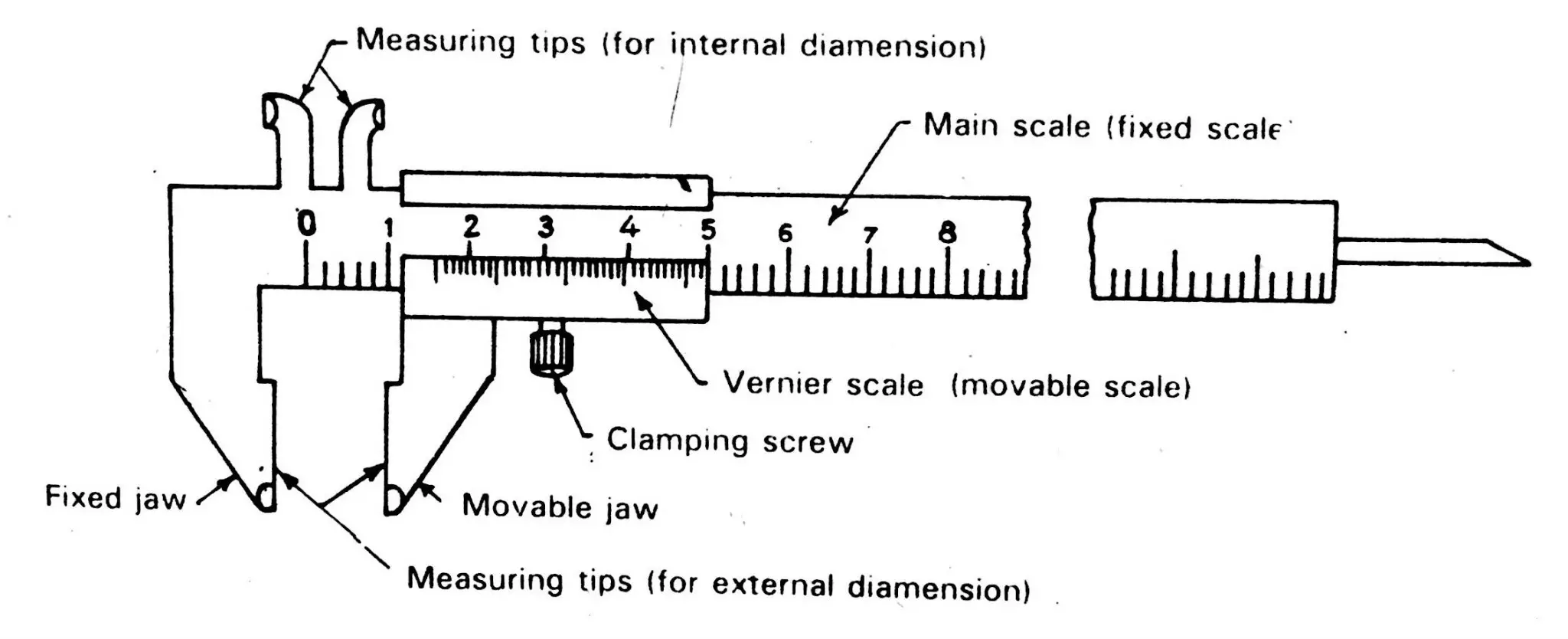A vernier caliper is a tool utilized to measure linear dimensions and determine the diameters of circular objects using its measuring jaws.
Index
History
Calipers can be traced back to the Qin dynasty in the 9th century A.D. and were later improved by French mathematician Pierre Vernier in 1631 with the addition of a vernier to reduce the margin of error.
Explanation
The Vernier calliper is a precise measuring tool that employs two scales – a main scale like a ruler and a Vernier scale that moves alongside the main scale.
The Vernier scale is uniquely graduated to allow for readings with a higher level of accuracy, down to a fraction of a division on the main scale.
These calipers are extensively utilized in scientific laboratories and manufacturing settings for quality control measurements.
Vernier calipers are favoured over flat instruments like rulers due to their high precision, with a minimal reading error of only 0.05mm or approximately 0.0019 inches.
There are two primary varieties of vernier calipers:
1. Manual
2. Digital
The manual caliper comes with two scales, one empirical and the other metric, while the digital caliper features an LCD screen that displays the reading.
Despite the availability of digital versions, manual vernier calipers remain popular because they are less expensive and do not rely on power.

Least Count
The vernier constant, also known as the least count of vernier calipers, is determined by finding the difference between one main scale division and one vernier scale division.
Mathematically, this can be represented as:
VC = 1 MSD – 1 VSD.
Or;
LC = 1MSD – 1VSD.
Where,
MSD is main scale division,
VSD is vernier scale division,
VC is vernier constant and
LC is the least count.
If there are n divisions on the vernier scale, which coincides with (n-1) division on the main scale, then the least count of the vernier caliper is:
\(LC = (1 – \frac{(n-1)}{n}) MSD = (\frac{1 MSD}{n})\)Using this formula, if there are 10 divisions on the vernier scale and each division on the main scale is 1 mm, then the least count of the vernier caliper would be 0.1 mm.
Preparation of Using Vernier Caliper
- Understand the different parts of the Vernier caliper, including the two jaws, the Vernier scale, and the main scale. Some Vernier calipers may also have a depth measurement device.
- Make sure the object you are measuring is clean, as even small amounts of dirt or grease can affect the accuracy of your measurements.
- Loosen the locking screw to prepare the Vernier caliper for use. Turn the screw clockwise to loosen it and counterclockwise to tighten it.
- Close the jaws of the Vernier caliper to get the most precise measurement. Make sure to zero out the reading before taking your measurement. This is especially important if you did not start with the caliper set to zero.
How to read Vernier Caliper?
- Begin by measuring nothing to ensure that the main and vernier scales are aligned.
- Confirm that the main and vernier scales are at zero to eliminate zero error.
- Place a ball between the jaws of the vernier scale.
- Observe the position of the 0 mark on the vernier scale relative to the main scale to obtain the main scale reading.
- Determine the point on the vernier scale that aligns with the main scale to obtain the vernier scale reading.
- Note that the readings are typically in decimal form.
- The number before the decimal point represents the main scale reading, while the number after the decimal point represents the vernier scale reading.
Applications
Some applications of Vernier Calipers are:
- Vernier calipers are utilized in the education sector for measuring the dimensions of regular and irregular objects from the interior or the exterior.
- In science labs, vernier calipers are used to measure apparatus with precision, ensuring error-free experiments.
- Vernier calipers are also used in medical applications for measuring surgical tools and other medical equipment.
- The steel sector employs vernier calipers to measure the length, breadth, and height of objects to ensure consistent product dimensions.
- In the aerospace sector, vernier calipers are used to measure even the minutest details of aerial parts to avoid accidents. These calipers have high precision, providing more accurate readings.
FAQ’S
The least count of the screw gauge is 0.01 mm, and that of the vernier caliper is 0.1 mm.
Two scales on the vernier caliper are:
Main scale that looks like the commonly used ruler.
Vernier scale that slides on the main scale.
The smallest measurement that can be measured using an instrument is called its least count.
If the angle of vision is improper, then there is a possibility of noting down wrong readings.
Similarly, if there is a lack of attentiveness, then there is a chance of recording inaccurate readings.
Therefore, it’s important to have a proper angle of vision and be attentive while noting down readings to avoid errors.
Related Topics
